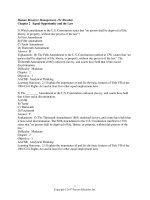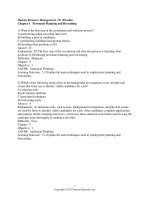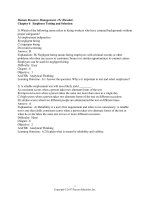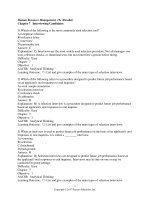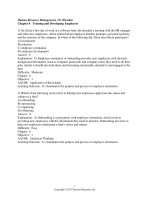Test bank algebra of ch02 graphs
Bạn đang xem bản rút gọn của tài liệu. Xem và tải ngay bản đầy đủ của tài liệu tại đây (1.63 MB, 64 trang )
Ch. 2 Graphs
2.1 Intercepts; Symmetry; Graphing Key Equations
1 Find Intercepts from an Equation
MULTIPLE CHOICE. Choose the one alternative that best completes the statement or answers the question.
List the intercepts for the graph of the equation.
1) y = x + 6
B) (-6, 0), (0, -6)
A) (6, 0), (0, -6)
2) y = 3x
A) (0, 0)
B) (0, 3)
3) y2 = x + 49
A) (7, 0), (0, 49), (0, -49)
C) (0, -7), (49, 0), (0, 7)
4
4) y = x
A) (1, 0)
C) (-6, 0), (0, 6)
D) (6, 0), (0, 6)
C) (3, 3)
D) (3, 0)
B) (0, -7), (-49, 0), (0, 7)
D) (-7, 0), (0, -49), (7, 0)
B) (0, 1)
C) (1, 1)
D) (0, 0)
5) x2 + y - 36 = 0
A) (0, -6), (36, 0), (0, 6)
C) (-6, 0), (0, -36), (6, 0)
B) (6, 0), (0, 36), (0, -36)
D) (-6, 0), (0, 36), (6, 0)
6) 4x2 + 9y2 = 36
A) (-4, 0), (-9, 0), (9, 0), (4, 0)
C) (-3, 0), (0, -2), (0, 2), (3, 0)
B) (-9, 0), (0, -4), (0, 4), (9, 0)
D) (-2, 0), (-3, 0), (3, 0), (2, 0)
7) 16x2 + y2 = 16
A) (-4, 0), (0, -1), (0, 1), (4, 0)
C) (-1, 0), (0, -16), (0, 16), (1, 0)
B) (-16, 0), (0, -1), (0, 1), (16, 0)
D) (-1, 0), (0, -4), (0, 4), (1, 0)
8) y = x3 - 1
A) (0, -1), (0, 1)
C) (-1, 0), (0, 1)
B) (0, -1), (1, 0)
9) y = x4 - 16
A) (0, 16)
C) (0, -16), (-2, 0), (2, 0)
B) (0, 16), (-2, 0), (2, 0)
D) (0, -16)
10) y = x2 + 14x + 48
A) (8, 0), (6, 0), (0, 48)
C) (-8, 0), (-6, 0), (0, 48)
B) (0, 8), (0, 6), (48, 0)
D) (0, -8), (0, -6), (48, 0)
11) y = x2 + 1
A) (0, 1), (-1, 0), (1, 0)
12) y =
B) (0, 1)
C) (1, 0)
4x
2
x + 16
A) (0, 0)
C) (-4, 0), (0, 0), (4, 0)
B) (-16, 0), (0, 0), (16, 0)
D) (0, -4), (0, 0), (0, 4)
Page 1
Copyright © 2013 Pearson Education, Inc.
D) (0, -1), (-1, 0)
D) (1, 0), (0, -1), (0, 1)
13) y =
x2 - 49
7x4
A) (-49, 0), (0, 0), (49, 0)
C) (-7, 0), (7, 0)
B) (0, -7), (0, 7)
D) (0, 0)
Page 2
Copyright © 2013 Pearson Education, Inc.
2 Test an Equation for Symmetry
MULTIPLE CHOICE. Choose the one alternative that best completes the statement or answers the question.
Plot the point A. Plot the point B that has the given symmetry with point A.
1) A = (-3, -1); B is symmetric to A with respect to the origin
y
5
4
3
2
1
-5
-4
-3
-2
-1
1
2
3
4
5
x
-1
-2
-3
-4
-5
A)
B)
y
y
5
5
4
4
3
3
2
2
1
1
B
-5
-4
-3
-2
-1
1
2
3
4
5
x
-5
-4
-3
-2
-1
-1
-1
-2
-2
1
2
3
4
5
x
1
2
3
4
5
x
A
-3
-3
B
A
-4
-4
-5
-5
C)
D)
y
y
5
5
4
4
3
3
2
2
1
1
B
-5
-4
-3
-2
-1
1
2
3
B
4
5
x
-5
-4
-3
-2
-1
-1
-1
-2
-2
-3
-3
-4
-4
-5
-5
A
A
Page 3
Copyright © 2013 Pearson Education, Inc.
2) A = (0, -1); B is symmetric to A with respect to the origin
y
5
4
3
2
1
-5
-4
-3
-2
-1
1
2
3
4
5
x
-1
-2
-3
-4
-5
A)
B)
y
y
5
5
4
4
3
3
2
2
B
1
1
A
-5
-4
-3
-2
B
-1
1
2
3
4
5
x
-1
-5
-1 A
-1
-2
-2
-3
-3
-4
-4
-5
-5
C)
-4
-3
-2
1
2
3
4
5
x
1
2
3
4
5
x
D)
y
y
5
5
4
4
3
3
2
2
1
1
B
-5
-4
-3
-2
B
-1 A
-1
1
2
3
4
5
x
-5
-4
-3
-2
-1 A
-1
-2
-2
-3
-3
-4
-4
-5
-5
Page 4
Copyright © 2013 Pearson Education, Inc.
List the intercepts of the graph.Tell whether the graph is symmetric with respect to the x -axis, y-axis, origin, or none of
these.
3)
y
10
5
-10
-5
5
10
x
-5
-10
A) intercepts: (0, -3) and (0, 3)
symmetric with respect to x-axis, y-axis, and origin
B) intercepts: (0, -3) and (0, 3)
symmetric with respect to y-axis
C) intercepts: (-3, 0) and (3, 0)
symmetric with respect to origin
D) intercepts: (-3, 0) and (3, 0)
symmetric with respect to x-axis, y-axis, and origin
4)
y
10
5
-10
-5
5
10
x
-5
-10
A) intercepts: (4, 0) and (-4, 0
symmetric with respect to y-axis
B) intercepts: (0, 4) and (0, -4)
symmetric with respect to x-axis, y-axis, and origin
C) intercepts: (0, 4) and (0, -4)
symmetric with respect to origin
D) intercepts: (4, 0) and (-4, 0)
symmetric with respect to x-axis, y-axis, and origin
Page 5
Copyright © 2013 Pearson Education, Inc.
5)
y
10
5
-10
-5
5
10
x
-5
-10
A) intercept: (0, 5)
symmetric with respect to x-axis
C) intercept: (5, 0)
no symmetry
B) intercept: (0, 5)
no symmetry
D) intercept: (5, 0)
symmetric with respect to y-axis
6)
y
10
5
-10
-5
5
10
x
-5
-10
A) intercept: (0, 3)
symmetric with respect to origin
C) intercept: (3, 0)
symmetric with respect to y-axis
B) intercept: (3, 0)
symmetric with respect to x-axis
D) intercept: (0, 3)
symmetric with respect to y-axis
Page 6
Copyright © 2013 Pearson Education, Inc.
7)
y
10
5
-10
-5
5
10
x
-5
-10
A) intercepts: (-1, 0), (0, 0), (1, 0)
symmetric with respect to y-axis
B) intercepts: (-1, 0), (0, 0), (1, 0)
symmetric with respect to x-axis, y-axis, and origin
C) intercepts: (-1, 0), (0, 0), (1, 0)
symmetric with respect to origin
D) intercepts: (-1, 0), (0, 0), (1, 0)
symmetric with respect to x-axis
Draw a complete graph so that it has the given type of symmetry.
8) Symmetric with respect to the y-axis
5
y
4
3
(0, 2)
2
1
-5
-4
-3
-2
-1
1
2
3
5 x
4
-1
-2
(2, -2)
-3
-4
-5
A)
B)
5
-5
-4
-3
-2
y
5
4
4
3
3
2
2
1
1
-1
1
2
3
4
5 x
-5
-4
-3
-2
-1
1
-1
-1
-2
-2
-3
-3
-4
-4
-5
-5
Page 7
Copyright © 2013 Pearson Education, Inc.
y
2
3
4
5 x
C)
D)
5
-5
-4
-3
-2
y
5
4
4
3
3
2
2
1
1
-1
1
2
3
4
5 x
-5
-4
-3
-2
y
-1
1
-1
-1
-2
-2
-3
-3
-4
-4
-5
-5
2
3
4
5 x
9) origin
5
y
4
3
2
1
-π
-π
2
π
2
-1
π
x
-2
-3
-4
-5
A)
B)
5
-π
-π
2
y
5
4
4
3
3
2
2
1
1
-1
π
2
π
x
-π
-π
2
-1
-2
-2
-3
-3
-4
-4
-5
-5
Page 8
Copyright © 2013 Pearson Education, Inc.
y
π
2
π
x
C)
D)
y
5
-π
2
-π
5
4
4
3
3
2
2
1
1
π
2
-1
π
x
-π
2
-π
y
π
2
-1
-2
-2
-3
-3
-4
-4
-5
-5
π
x
4
5 x
10) Symmetric with respect to the x-axis
5
y
4
3
2
(3, 1)
1
(2, 0)
-5
-4
-3
-2
-1
1
2
3
5 x
4
-1
-2
-3
-4
-5
A)
B)
5
-5
-4
-3
-2
y
5
4
4
3
3
2
2
1
1
-1
1
2
3
4
5 x
-5
-4
-3
-2
-1
1
-1
-1
-2
-2
-3
-3
-4
-4
-5
-5
Page 9
Copyright © 2013 Pearson Education, Inc.
y
2
3
C)
D)
5
-5
-4
-3
-2
y
5
4
4
3
3
2
2
1
1
-1
1
2
3
4
5 x
-5
-4
-3
-2
-1
y
1
-1
-1
-2
-2
-3
-3
-4
-4
-5
-5
2
3
4
5 x
List the intercepts and type(s) of symmetry, if any.
11) y2 = -x + 4
A) intercepts: (-4, 0), (0, 2), (0, -2)
symmetric with respect to x-axis
C) intercepts: (0, -4), (2, 0), (-2, 0)
symmetric with respect to y-axis
B) intercepts: (0, 4), (2, 0), (-2, 0)
symmetric with respect to y-axis
D) intercepts: (4, 0), (0, 2), (0, -2)
symmetric with respect to x-axis
12) 9x2 + 4y2 = 36
A) intercepts: (3, 0), (-3, 0), (0, 2), (0, -2)
symmetric with respect to x-axis and y-axis
B) intercepts: (2, 0), (-2, 0), (0, 3), (0, -3)
symmetric with respect to x-axis and y-axis
C) intercepts: (2, 0), (-2, 0), (0, 3), (0, -3)
symmetric with respect to x-axis, y-axis, and origin
D) intercepts: (3, 0), (-3, 0), (0, 2), (0, -2)
symmetric with respect to the origin
13) y =
-x
2
x - 2
A) intercepts: ( 2, 0), (- 2, 0), (0, 0)
symmetric with respect to origin
C) intercept: (0, 0)
symmetric with respect to x-axis
B) intercept: (0, 0)
symmetric with respect to y-axis
D) intercept: (0, 0)
symmetric with respect to origin
Determine whether the graph of the equation is symmetric with respect to the x -axis, the y-axis, and/or the origin.
14) y = x + 1
A) y-axis
B) x-axis
C) origin
D) x-axis, y-axis, origin
E) none
Page 10
Copyright © 2013 Pearson Education, Inc.
15) y = -3x
A) x-axis
B) y-axis
C) origin
D) x-axis, y-axis, origin
E) none
16) x2 + y - 4 = 0
A) origin
B) y-axis
C) x-axis
D) x-axis, y-axis, origin
E) none
17) y2 - x - 9 = 0
A) origin
B) y-axis
C) x-axis
D) x-axis, y-axis, origin
E) none
18) 9x2 + 16y2 = 144
A) x-axis
B) origin
C) y-axis
D) x-axis, y-axis, origin
E) none
19) 16x2 + y2 = 16
A) y-axis
B) origin
C) x-axis
D) x-axis, y-axis, origin
E) none
20) y = x2 + 14x + 45
A) y-axis
B) x-axis
C) origin
D) x-axis, y-axis, origin
E) none
21) y =
3x
2
x + 9
A) origin
B) y-axis
C) x-axis
D) x-axis, y-axis, origin
E) none
Page 11
Copyright © 2013 Pearson Education, Inc.
22) y =
x2 - 16
4x4
A) x-axis
B) origin
C) y-axis
D) x-axis, y-axis, origin
E) none
23) y = 4x2 + 5
A) y-axis
B) origin
C) x-axis
D) x-axis, y-axis, origin
E) none
24) y = (x + 6)(x - 8)
A) y-axis
B) x-axis
C) origin
D) x-axis, y-axis, origin
E) none
25) y = -7x3 + 2x
A) origin
B) y-axis
C) x-axis
D) x-axis, y-axis, origin
E) none
26) y = -5x4 - 9x + 3
A) y-axis
B) origin
C) x-axis
D) x-axis, y-axis, origin
E) none
Solve the problem.
27) If a graph is symmetric with respect to the y-axis and it contains the point (5, -6), which of the following points
is also on the graph?
C) (-6, 5)
D) (-5, 6)
A) (5, -6)
B) (-5, -6)
28) If a graph is symmetric with respect to the origin and it contains the point ( -4, 7), which of the following points
is also on the graph?
A) (7, -4)
B) (4, -7)
C) (-4, -7)
D) (4, 7)
Page 12
Copyright © 2013 Pearson Education, Inc.
3 Know How to Graph Key Equations
MULTIPLE CHOICE. Choose the one alternative that best completes the statement or answers the question.
Graph the equation by plotting points.
1) y = x3
y
10
5
-10
-5
5
x
10
-5
-10
A)
B)
y
-10
y
10
10
5
5
-5
5
10
x
-10
-5
-5
-5
-10
-10
C)
5
10
x
5
10
x
D)
y
-10
y
10
10
5
5
-5
5
10
x
-10
-5
-5
-5
-10
-10
Page 13
Copyright © 2013 Pearson Education, Inc.
2) x = y2
y
10
5
-10
-5
5
x
10
-5
-10
A)
B)
y
-10
y
10
10
5
5
-5
5
10
x
-10
-5
-5
-5
-10
-10
C)
5
10
x
5
10
x
D)
y
-10
y
10
10
5
5
-5
5
10
x
-10
-5
-5
-5
-10
-10
Page 14
Copyright © 2013 Pearson Education, Inc.
3) y = x
y
10
5
-10
-5
5
x
10
-5
-10
A)
B)
y
-10
y
10
10
5
5
-5
5
10
x
-10
-5
-5
-5
-10
-10
C)
5
10
x
5
10
x
D)
y
-10
y
10
10
5
5
-5
5
10
x
-10
-5
-5
-5
-10
-10
Page 15
Copyright © 2013 Pearson Education, Inc.
4) y =
1
x
y
5
-5
x
5
-5
A)
B)
y
y
5
5
-5
5
x
-5
-5
5
x
5
x
-5
C)
D)
y
y
5
-5
5
5
x
-5
-5
-5
Page 16
Copyright © 2013 Pearson Education, Inc.
2.2 Lines
1 Calculate and Interpret the Slope of a Line
MULTIPLE CHOICE. Choose the one alternative that best completes the statement or answers the question.
Find the slope of the line through the points and interpret the slope.
1)
y
10
5
(11, 1)
(0, 0)
-10
-5
5
x
10
-5
-10
A) -11; for every 1-unit increase in x, y will decrease by 11 units
1
B) - ; for every 11-unit increase in x, y will decrease by 1 unit
11
C) 11; for every 1-unit increase in x, y will increase by 11 units
1
; for every 11-unit increase in x, y will increase by 1 unit
D)
11
Find the slope of the line.
2)
y
10
5
-10
-5
5
x
10
-5
-10
A)
1
2
B) -
1
2
C) 2
Page 17
Copyright © 2013 Pearson Education, Inc.
D) - 2
3)
y
10
5
-10
-5
5
x
10
-5
-10
B) -2
A) 2
C) 1
D) -1
C) 1
D) -3
1
2
D) -
4)
y
10
5
-10
-5
5
x
10
-5
-10
A) -1
B) 3
5)
y
10
5
-10
-5
5
x
10
-5
-10
A) 2
B) -2
C)
Find the slope of the line containing the two points.
6) (8, -4); (-9, 1)
17
5
A)
B) -
5
17
C) -
17
5
Page 18
Copyright © 2013 Pearson Education, Inc.
D)
1
2
5
17
7) (7, 0); (0, 2)
2
A) -
7
7
2
C)
7
2
D)
B) - 3
C)
1
3
D) -
B) -3
C) 0
D) undefined
B) -6
C)
1
6
D) undefined
B) -
2
7
8) (-3, 7); (2, -8)
A) 3
9) (-7, 2); (-7, -1)
1
A)
3
1
3
10) (3, 7); (-3, 7)
A) 0
Page 19
Copyright © 2013 Pearson Education, Inc.
2 Graph Lines Given a Point and the Slope
MULTIPLE CHOICE. Choose the one alternative that best completes the statement or answers the question.
Graph the line containing the point P and having slope m.
12
1) P = (3, -7); m =
5
y
10
5
-10
-5
5
x
10
-5
-10
A)
B)
y
-10
y
10
10
5
5
-5
5
10
x
-10
-5
-5
-5
-10
-10
C)
5
10
x
5
10
x
D)
y
-10
y
10
10
5
5
-5
5
10
x
-10
-5
-5
-5
-10
-10
Page 20
Copyright © 2013 Pearson Education, Inc.
2) P = (-5, -7); m =
3
2
y
10
5
-10
-5
5
10
x
-5
-10
A)
B)
y
-10
y
10
10
5
5
-5
5
10
x
-10
-5
-5
-5
-10
-10
C)
5
10
x
5
10
x
D)
y
-10
y
10
10
5
5
-5
5
10
x
-10
-5
-5
-5
-10
-10
Page 21
Copyright © 2013 Pearson Education, Inc.
3) P = (-2, 0); m = -2
y
10
5
-10
-5
5
10
x
-5
-10
A)
B)
y
-10
y
10
10
5
5
-5
5
10
x
-10
-5
-5
-5
-10
-10
C)
5
10
x
5
10
x
D)
y
-10
y
10
10
5
5
-5
5
10
x
-10
-5
-5
-5
-10
-10
Page 22
Copyright © 2013 Pearson Education, Inc.
4) P = (0, 6); m =
3
5
y
10
5
-10
-5
5
10
x
-5
-10
A)
B)
y
-10
y
10
10
5
5
-5
5
10
x
-10
-5
-5
-5
-10
-10
C)
5
10
x
5
10
x
D)
y
-10
y
10
10
5
5
-5
5
10
x
-10
-5
-5
-5
-10
-10
Page 23
Copyright © 2013 Pearson Education, Inc.
5) P = (0, 6); m = -
4
3
y
10
5
-10
-5
5
10
x
-5
-10
A)
B)
y
-10
y
10
10
5
5
-5
5
10
x
-10
-5
-5
-5
-10
-10
C)
5
10
x
5
10
x
D)
y
-10
y
10
10
5
5
-5
5
10
x
-10
-5
-5
-5
-10
-10
Page 24
Copyright © 2013 Pearson Education, Inc.
6) P = (-3, 0); m = 2
y
10
5
-10
-5
5
10
x
-5
-10
A)
B)
y
-10
y
10
10
5
5
-5
5
10
x
-10
-5
-5
-5
-10
-10
C)
5
10
x
5
10
x
D)
y
-10
y
10
10
5
5
-5
5
10
x
-10
-5
-5
-5
-10
-10
Page 25
Copyright © 2013 Pearson Education, Inc.


